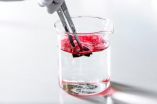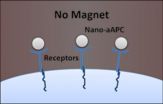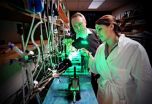(Press-News.org) We live surrounded by polymers and today, rather than come up with new polymers, there is a tendency to modify them in order to obtain new applications. Carbon nanotubes have excellent mechanical properties, are very tough, very rigid, and what is more, they conduct electricity. "The problem with them is that they get dispersed, in other words, it's very difficult to get them to blend with polymers," explained Iñaki Eguiazabal, a member of the Polymer Technology Group. That is why it is essential to come up with methods that will enablethe carbon nanotubes to have a high degree of dispersion and stabilitywithin the polymer matrix. "In this research we have come up with the successful preparation of one of these materials," he added.
The research aimed to improve the mechanical properties of poly(ether imide). Poly(ether imide) is a polymer that has very good mechanical and thermal properties and is used, among other things, to produce the internal parts of aircraft. However, like most polymers it is an insulating material from the electrical perspective. "By adding carbon nanotubes, we are not only able to improve the mechanical properties of the material even further, we can also turn it into a conductor of electricity," explained IñakiEguiazabal. This could enable them to be used in electrostatic painting applications, among other things.
Right from the start, the activity of the Polymer Technology Group, which is part of the UPV/EHU's Department of Polymer Science and Technology and the Institute for Polymer Materials, POLYMAT, has concentrated mainly on the study of polymer blends in order to obtain new materials with optimized features.
Right now, the Group's most recent line of work is focussing on the study of nanocomposite systems consisting of thermoplastic polymers and organically modified laminated clays or carbon nanotubes. New nano-reinforced materials based on technical polymers, and in the case of systems with carbon nanotubes, conductors of electricity, have been developed in this line. Ternary systems based on polymer blends to which nanoparticles have been added have enabled the advantages offered by the blendto be combined with those provided by nanocomposites; this includes the obtaining of super-tough materials with an optimized range of properties.
The paper entitled "Widely dispersed PEI-based nanocomposites with multi-wall carbon nanotubes by blending with a masterbatch" has been published recently in the specialised journal Composites, Part A: Applied Science and Manufacturing, one of the most important ones in its category. The authors are PhD-holders Imanol González and IñakiEguiazabal and their paper deals with an application of the above-mentioned synergy between polymer blends and nanocomposites.
Better dispersion and increase in electrical conductivity
For the case of poly(ether imide), they resorted to incorporating a blend based on poly(butylene terephthalate)into the polymer with a high concentration of dispersed nanotubes. In actual fact,"poly(butylene terephthalate)does not have the splendid properties displayed by the polymer we are trying to improve, but both polymers blend very well and that way we can get the dispersion to extend right across the blend," Eguiazabal pointed out.
"Although thermal stability is reduced, electrical conductivity is obtained by adding 1% of carbon nanotubes," he added. On the other hand, "the mechanical properties of the poly(ether imide) improve it even more. "Finally, to all this is added the fact that the viscosity of the nanocomposites is seen to be significantly reduced thanks to the presence of the poly(butylene terephthalate), which constitutes a considerable improvement in the processability of the materials, despite the presence of the nanotubes that tend to increase viscosity. This reduction in viscosity makes it possible to obtain products with sections of very little thickness but with complex geometry.
INFORMATION: END
Improvement in polymers for aviation
2014-02-25
ELSE PRESS RELEASES FROM THIS DATE:
'Greener' aerogel technology holds potential for oil and chemical clean-up
2014-02-25
MADISON, Wis. – Cleaning up oil spills and metal contaminates in a low-impact, sustainable and inexpensive manner remains a challenge for companies and governments globally.
But a group of researchers at the University of Wisconsin–Madison is examining alternative materials that can be modified to absorb oil and chemicals without absorbing water. If further developed, the technology may offer a cheaper and "greener" method to absorb oil and heavy metals from water and other surfaces.
Shaoqin "Sarah" Gong, a researcher at the Wisconsin Institute for Discovery (WID) ...
Glycerol phenylbutyrate reduces hepatic encephalopathy events
2014-02-25
Phase 2 trial results published in the March issue of Hepatology, a journal of the American Association for the Study of Liver Diseases, suggests the potential for Glycerol Phenylbutyrate (GPB) to reduce hepatic encephalopathy episodes in patients with cirrhosis, with a safety profile similar to placebo.
Patients with hepatic encephalopathy experience neuropsychiatric symptoms that may range from mild confusion to coma. There is conflicting evidence on the link between elevated blood ammonia and hepatic encephalopathy. Poorly-absorbable disaccharides and antibiotics ...
Sensor-based irrigation systems show potential to increase greenhouse profitability
2014-02-25
COLLEGE PARK, MD--Wireless sensor-based irrigation systems can offer significant benefits to greenhouse operators. Advances in sensor technology and increased understanding of plant physiology have made it possible for greenhouse growers to use water content sensors to accurately determine irrigation timing and application rates in soilless substrates. The wireless sensor systems provide more accurate measurements of substrate moisture than qualitative methods, and can save irrigation water, labor, energy, and fertilizer. The authors of a report published in HortTechnology ...
Technique to create holes in graphene could improve water filters, desalination
2014-02-25
Researchers have devised a way of making tiny holes of controllable size in sheets of graphene, a development that could lead to ultrathin filters for improved desalination or water purification.
The team of researchers at MIT, Oak Ridge National Laboratory, and in Saudi Arabia succeeded in creating subnanoscale pores in a sheet of the one-atom-thick material, which is one of the strongest materials known. Their findings are published in the journal Nano Letters.
The concept of using graphene, perforated by nanoscale pores, as a filter in desalination has been proposed ...
Report details multiple commercial uses of wireless sensor networks
2014-02-25
ATHENS, GA--Managing the quality and quantity of freshwater resources is one of the most serious environmental challenges of the 21st century. Global population growth and increasing urbanization have resulted in increased competition for water resources among domestic, industrial, and agricultural users. Challenged to find ways to manage irrigation needs while recognizing the limitations of freshwater resources, many commercial horticulture operations are showing increased interest in the use of wireless sensor networks (WSN)--technology designed to both monitor and control ...
Analysis: 32 years of US filicide arrests
2014-02-25
PROVIDENCE, R.I. [Brown University] — Instances in which parents kill their children may seem so horrifying and tragic that they defy explanation. Published scientific and medical research, meanwhile, doesn't offer much epidemiological context to help people understand patterns among such heinous crimes. A paper in the March edition of the journal Forensic Science International provides the first comprehensive statistical analysis of filicide in the United States, drawing on 32 years of data on more than 94,000 arrests. The study also explores possible underlying psychiatric ...
CWRU researchers find byproducts of bacteria-causing gum disease incite oral cancer growth
2014-02-25
Researchers from Case Western Reserve University have discovered how byproducts in the form of small fatty acids from two bacteria prevalent in gum disease incite the growth of deadly Kaposi's sarcoma-related (KS) lesions and tumors in the mouth.
The discovery could lead to early saliva testing for the bacteria, which, if found, could be treated and monitored for signs of cancer and before it develops into a malignancy, researchers say.
"These new findings provide one of the first looks at how the periodontal bacteria create a unique microenvironment in the oral cavity ...
Eliminating maternal mortality could extend life expectancy in reproductive ages
2014-02-25
Maternal death rates represent the single largest health discrepancy between developed and developing populations, with nearly all - over 99% -- maternal deaths worldwide occurring in developing countries and over half of them in sub-Saharan Africa countries. Eliminating maternal mortality, which is defined as the deaths related to pregnancy, would result in a gain of over a half year (0.6 years) in life expectancy worldwide, according to a new study by researchers at Johns Hopkins Bloomberg School of Public Health. The study is published February 13 in PLOS ONE.
Over ...
Magnetic medicine
2014-02-25
Using tiny particles designed to target cancer-fighting immune cells, Johns Hopkins researchers have trained the immune systems of mice to fight melanoma, a deadly skin cancer. The experiments, described on the website of ACS Nano on February 24, represent a significant step toward using nanoparticles and magnetism to treat a variety of conditions, the researchers say.
"Size was key to this experiment," says Jonathan Schneck, M.D., Ph.D., a professor of pathology, medicine and oncology at the Johns Hopkins University School of Medicine's Institute for Cell Engineering. ...
3-D printer creates transformative device for heart treatment
2014-02-25
Igor Efimov, PhD, at the School of Engineering & Applied Science at Washington University in St. Louis and an international team of biomedical engineers and materials scientists have created a 3-D elastic membrane made of a soft, flexible, silicon material that is precisely shaped to match the heart's epicardium, or the outer layer of the wall of the heart. Current technology is two-dimensional and cannot cover the full surface of the epicardium or maintain reliable contact for continual use without sutures or adhesives.
The team can then print tiny sensors onto the membrane ...



